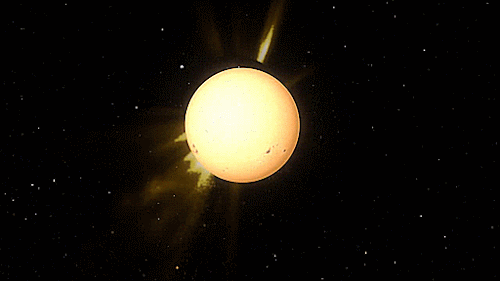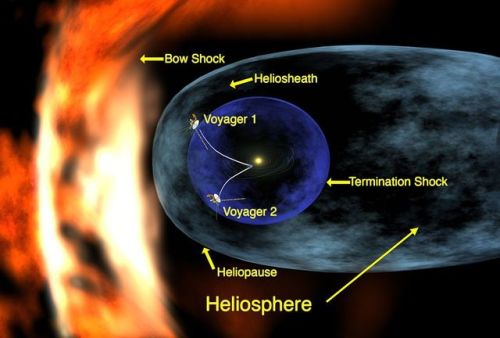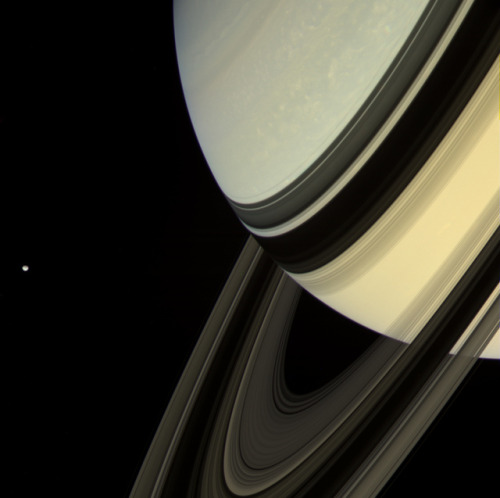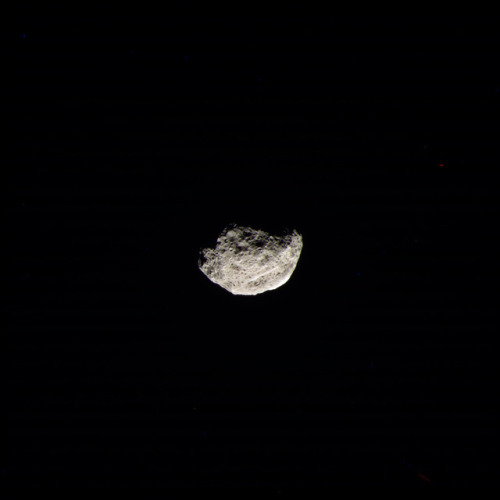Picture Of The Day - February 13, 2019 (Late Post)

Picture of the Day - February 13, 2019 (Late post)
Uniquely colored desert world with life.
More Posts from Sharkspaceengine and Others




The heliosphere is the bubble-like region of space dominated by the Sun, which extends far beyond the orbit of Pluto. Plasma “blown” out from the Sun, known as the solar wind, creates and maintains this bubble against the outside pressure of the interstellar medium, the hydrogen and helium gas that permeates the Milky Way Galaxy. The solar wind flows outward from the Sun until encountering the termination shock, where motion slows abruptly. The Voyager spacecraft have explored the outer reaches of the heliosphere, passing through the shock and entering the heliosheath, a transitional region which is in turn bounded by the outermost edge of the heliosphere, called the heliopause. The shape of the heliosphere is controlled by the interstellar medium through which it is traveling, as well as the Sun and is not perfectly spherical. The limited data available and unexplored nature of these structures have resulted in many theories. The word “heliosphere” is said to have been coined by Alexander J. Dessler, who is credited with first use of the word in the scientific literature.
On September 12, 2013, NASA announced that Voyager 1 left the heliopause on August 25, 2012, when it measured a sudden increase in plasma density of about forty times. Because the heliopause marks one boundary between the Sun’s solar wind and the rest of the galaxy, a spacecraft such as Voyager 1 which has departed the heliosphere, can be said to have reached interstellar space. source


In honor of NASA’s successful landing of the InSight Lander, here are a couple of Space Engine pictures of Mars centered on the Elysium Planitia.
Had to take a second closer picture since Phobos got in the way of the first picture.
High Resolution Pictures
Picture 1
Picture 2






Pictures of the day - December 22, 2018
Insight System - Sixth Planet (Insight A-VI)
Insight A-Vi is an Earth-like water-world with a surface completely covered in oceans. The planet has a mass of 0.65 Earths and a diameter 0.97 times that of our planet. An extensive ring system surrounds the planet and the oceans contain simple signed-celled life.
The planet orbits at an average distance of 1.10 AU and a day on the surface lasts 18 hours and 31 minutes. Compared to the inner-worlds, Insight A-VI is rather cold with an average global temperature of 41 F. Still the oceans absorb enough heat that there are no ice caps at the poles, since ocean currents keep the water from freezing.
Note the inner two planets have comet like appearance from their atmospheres being strip away by the sun.
High Resolution Pictures
Insight A-VI
Three small moons
Rings
The sun and inner planets
Sunset
Planet rise




Pictures of the day - January 1, 2019
A set of skylines from a large moon of a gas giant.
Space Engine System ID: RS 5581-7-7-1842438-367 A5.1 to visit the moon in Space Engine










Saturn, rings and moons
NASA/JPL-Caltech/SSI/Kevin M. Gill
Busy & Hazy Sky

Picture of the Day 2 - October 23, 2018
Another beautiful aurora shot, looking towards a gas giant under a hazy atmosphere. The Andromeda galaxy is visible to the right of the picture as a hazy bright spot just below the aurora.
The Andromeda Galaxy will be the next galaxy I will be exploring in space engine beginning next month.

Picture of the day 2 - November 28, 2018
Cratered surface of a small burnt dwarf planet. Fissures run through the surface from the core cooling and the crust shrinking.
What are white dwarfs?
Some curiosities about white dwarfs, a stellar corpse and the future of the sun.

Where a star ends up at the end of its life depends on the mass it was born with. Stars that have a lot of mass may end their lives as black holes or neutron stars.

A white dwarf is what stars like the Sun become after they have exhausted their nuclear fuel. Near the end of its nuclear burning stage, this type of star expels most of its outer material, creating a planetary nebula.

In 5.4 billion years from now, the Sun will enter what is known as the Red Giant phase of its evolution. This will begin once all hydrogen is exhausted in the core and the inert helium ash that has built up there becomes unstable and collapses under its own weight. This will cause the core to heat up and get denser, causing the Sun to grow in size.
It is calculated that the expanding Sun will grow large enough to encompass the orbit’s of Mercury, Venus, and maybe even Earth.

A typical white dwarf is about as massive as the Sun, yet only slightly bigger than the Earth. This makes white dwarfs one of the densest forms of matter, surpassed only by neutron stars and black holes.
The gravity on the surface of a white dwarf is 350,000 times that of gravity on Earth.

White dwarfs reach this incredible density because they are so collapsed that their electrons are smashed together, forming what is called “degenerate matter.” This means that a more massive white dwarf has a smaller radius than its less massive counterpart. Burning stars balance the inward push of gravity with the outward push from fusion, but in a white dwarf, electrons must squeeze tightly together to create that outward-pressing force. As such, having shed much of its mass during the red giant phase, no white dwarf can exceed 1.4 times the mass of the sun.

While many white dwarfs fade away into relative obscurity, eventually radiating away all of their energy and becoming a black dwarf, those that have companions may suffer a different fate.

If the white dwarf is part of a binary system, it may be able to pull material from its companion onto its surface. Increasing the mass can have some interesting results.
One possibility is that adding more mass to the white dwarf could cause it to collapse into a much denser neutron star.

A far more explosive result is the Type 1a supernova. As the white dwarf pulls material from a companion star, the temperature increases, eventually triggering a runaway reaction that detonates in a violent supernova that destroys the white dwarf. This process is known as a single-degenerate model of a Type 1a supernova.

If the companion is another white dwarf instead of an active star, the two stellar corpses merge together to kick off the fireworks. This process is known as a double-degenerate model of a Type 1a supernova.

At other times, the white dwarf may pull just enough material from its companion to briefly ignite in a nova, a far smaller explosion. Because the white dwarf remains intact, it can repeat the process several times when it reaches the critical point, briefly breathing life back into the dying star over and over again.
Image credit: www.aoi.com.au, NASA, Wikimedia Commons, Fsgregs, quora.com, quora.com, NASA’s Goddard Space Flight Center, S. Wiessinger, ESO, ESO, Chandra X-ray Observatory
Source: NASA, NASA, space.com





Picture of the day - December 26, 2018
Insight A System - Ninth Planet (Insight A-IX)
Insight A-IX is the Insight A systems second largest and second most massive planet. It is an ice giant 17.40 times more massive than Earth, and has a radius of 3.28 Earth Radii. The planet is surrounded by a narrow yet well structured ring system, and a system of 6 small ellipsoidal satellites.
The planet orbits it’s sun at an average distance of 7.34 AU, completing 1 orbit every 18.35 Years. A day on the planet lasts just 9 hours and 6 minutes. The planet has a thick hydrogen/ helium atmosphere, and has an average atmospheric temperature of -279 F.
High Resolution Pictures
Insight A-IX
Small moon
Narrow Rings
Ring Closeup
Crescent
-
 marysmirages liked this · 2 years ago
marysmirages liked this · 2 years ago -
 sweet-verses liked this · 6 years ago
sweet-verses liked this · 6 years ago -
 lulu-stotts reblogged this · 6 years ago
lulu-stotts reblogged this · 6 years ago -
 sharkspaceengine reblogged this · 6 years ago
sharkspaceengine reblogged this · 6 years ago
My Space Engine Adventures, also any space related topic or news. www.spaceengine.org to download space engine. The game is free by the way. Please feel free to ask me anything, provide suggestions on systems to visit or post any space related topic.Check out my other blog https://bunsandsharks.tumblr.com for rabbit and shark blog.
294 posts
